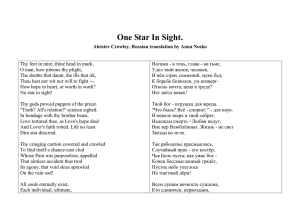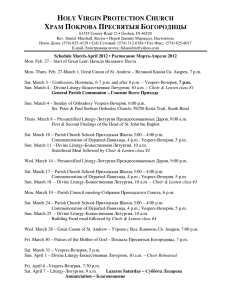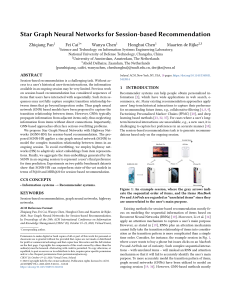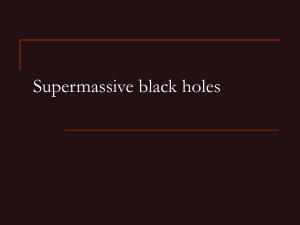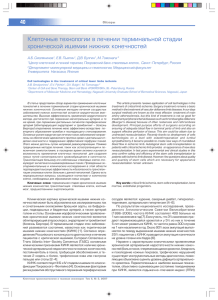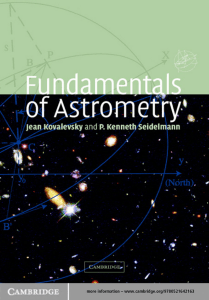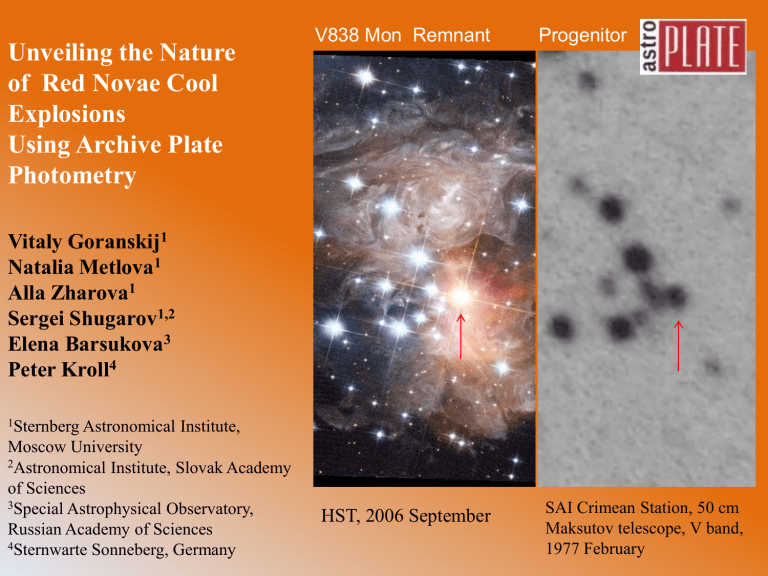
Unveiling the Nature of Red Novae Cool Explosions Using Archive Plate Photometry V838 Mon Remnant Progenitor Vitaly Goranskij1 Natalia Metlova1 Alla Zharova1 Sergei Shugarov1,2 Elena Barsukova3 Peter Kroll4 1Sternberg Astronomical Institute, Moscow University 2Astronomical Institute, Slovak Academy of Sciences 3Special Astrophysical Observatory, Russian Academy of Sciences 4Sternwarte Sonneberg, Germany HST, 2006 September SAI Crimean Station, 50 cm Maksutov telescope, V band, 1977 February What are the red novae? The new class of Stars Erupting into Cool Supergiants (SECS, Munari et al., 2002) Objects: V1006/7 in M31 = RV = McD 1988 No.1 V4332 Sgr, 1994* V838 Mon, 2002* V1309 Sco, 2008 V1148 Sgr, 1943 (no photometry) OGLE-2002-BLG-360 ? (no spectra) A typical spectrum of a red nova in outburst. It is K0 I of V838 Mon. OT 2006-1 in M85 ? (too luminous) PTF 10fqs in M99 ? (too luminous) V4332 Sgr is an old-age object at the Galactic latitude of –9.4°. Halo or thick disk object. *) There are observations of progenitors in Moscow and Sonneberg collections V838 Mon is a young object associated with the cluster of B stars and the dust environment. Observations 40 cm astrograph, SAI Crimean Station. Field 10×10°, scale 120ʺ/mm, exposures of 45 min, plate limit ~17 mag 50 cm meniscus Maksutov telescope AZT-5. Field 3.7×3.7°, scale 103ʺ/mm, exposures of 60 min, plate limit ~20 mag Digitization SAI CREO scanner TIFF Eastmen Kodak image FinePix F10 camera JPEG FujiFilm, grey mode + ordinary convex lens [!] image BITMAP MaxIm DL Change cuts image BITMAP MS Paint image The second method can’t be used for wide fields due to lens distortion but is good for a single star with outskirts. It may be widely used by students and amateurs even without support stands. AZT-5 B Influence of a close star. V Fragments of frames distorted by a brighter star were changed by fragments of a blank sky from the same frame. telescope archive CREO scans V4332 Sgr POSS O 1950 CCD B: 2005. 06. 08 1980. 07. 14 1986. 06. 07 1986. 06. 15 1977. 06.17 1980. 07. 15 1986. 06. 08 22 Pixel value vs distance from the star center relation Digital Reduction The software interface Background Subtracted profile Zero pixels Subtracted profile Another way to correct pixels of measured star distorted by neighbor stars is shown. We send zero values to distorted pixels. Then star profile center is calculated without them. In calculation of integral signal, the distorted values are changed with average profile values. Then average profile is subtracted from the image of the star. Lens distortion is visible at the edge of the frame. The characteristic curve was approximated by a 1-st or 2-nd order polynomial. 17-23 comparison stars were used. V4332 Sgr The Light Curve. Progenitor became brighter by ~ 1m before the 1994 outburst. Remnant has weakened abruptly between 2006 and 2008, and its temperature decreased by ~1000 K. Spectral Energy Distributions of the Progenitor and the Remnant. Distributions of the remnant are given for the continuum of the red M type star, the contribution of emission lines is subtracted. The progenitor was a red star with the blue excess. The excess vanished after the outburst, but the red star remained at the same level. V4332 Sgr Spectroscopy of the remnant Cool (1050 K) gas nebula + M type star. Fluxes of the nebula decreased between 2003 and 2012 by ~30 times with exponential law. Continuum intensity of M star changed abruptly in the blue region by 4 times, with the blackbody temperature dropped by 1000 K. Possible nature of V4332 Sgr: –Explosion of a blue straggler in the system with an M giant. Straggler might be a contact binary system, and the event might be a merger. First it passed stage of common envelope (pre-outburst brightening as in V1309 Sco). –Interaction of merger with the M giant was observed, but the M star was not the exploded star. Photometrically calibrated BTA/SCORPIO spectra in the blue region V838 Mon Photometric evolution 148 B band plates AGFA Astro/ORWO ZU2&ZU21, 1928 – 1994 in Sonneberg and Moscow suitable for eye estimates. 57 of them are good for measurement (accuracy varies within 0 m.06 – 0m.23, mean 0m.13). 50 V band Kodak 103aD + V filter in Moscow (all good for measurement, accuracy 0m.04 – 0m.20, mean 0m.08). The progenitor of V838 Mon was a binary system of B type stars. We were able to separate contributions of both components in common light as the light lost in explosion or in eclipse. In the first case, exploded star remnant disappeared from B and V bands because its spectrum shifted to the red due to cooling. And its lost light was measured in BV bands. In the second case, the secondary star disappeared in all bands of UBVRI system, and its lost light was measured in each band. The light of exploded star was found as difference between common light and light of B type companion. Spectral evolution of V838 Mon remnant B3V companion and cool M-type stellar remnant. Approach of B3V companion to M star: emission lines strengthen due to ionization of cool gas. Submergence the companion to M star: strong emission, B-type star still visible . B-type star is in the void under the exterior shell. B star disappeared totally inside the remnant, emissions vanished. Zero fluxes are seen in the bottom of TiO bands. Calibrated BTA/SCORPIO spectra, 2004 –2009 V838 Mon progenitor B6V V838 Mon progenitor Pair of B3V B4V B3V Afsar-Bond cluster. Photographic V band image taken 25 years before the explosion Energy distributions of combined light of the with the 50 cm Maksutov АZТ-5 telescope of binary (top), B3V type companion (bottom), SAI Crimean Station on 1977 September 21. and exploded component (middle, compared with HD 29763, B3V). A pair of B3V type stars of V838 Mon AZT-5(V)+ 40-cm astrograph (B)+ DSS (RI) progenitor looks fainter than single B3V type cluster member. They are unusual subluminous stars. Afsar-Bond Cluster Photographic and CCD photometry Location of V838 Mon components in Color-Magnitude and Color-Color diagram plotted for nearby stars Three B-type stars and two components of V838 Mon belong to Afsar-Bond cluster. Cluster members and V838 Mon components have similar reddening. Spectra of faint nearby stars taken with 6 m telescope BTA show that they are foreground objects. Location of V838 Mon components in the SpectrumLuminosity Diagram Fragment from Fig. 1 by Schaller et al. (1992) Basic data sources: Distance 6.1 ± 0.6 kpc (Bond et al., 2008; echo); Reddening E(B–V) = 0.87 mag, AV = 2.68 mag (Munari et al., 2005); [our value is 0.77 mag]; Spectra of cluster members and V838 Mon companion from Afsar & Bond (2007); Photometry in the V band is ours; Bolometric corrections of B-type stars from Nieva & Przybilla (IAUS 272, Paris, 2010); Evolutionary tracks from Schaller et al. (1992), Y=0.300, Z=0.020. Examination of V838 Mon progenitor‘s V magnitude series for periodicity It is known that the light contribution of exploded star in a binary was 57.6 per cent. These two best periods are of low significance Only this dense 640-day portion was used for calculations Deeming amplitude spectrum. Peak probabilities are compared with those of a chaotic series. 6 Pre-outburst expansion of the envelope in the condition close to adiabatic V1309 Sco (Tylenda et al., 2009) Radius of V838 Mon estimated using Stephan-Boltzmann formula L = 4πR2σT4. When the outburst began, the star had already large radius and its surface area had increased by 12700 times. The luminosity increased only by 220 times. Forming of the massive common envelope and its adiabatic expansion in V1309 Sco before the outburst. The exploded star’s envelope has undergone pre-outburst expansion in the conditions close to adiabatic which continued at least four years. Nature of cool explosions In a massive star experienced a central energy release, the massive envelope gets a slow push inside. The radiation transfer time exceeds its dynamic expansion time by many orders of value, so the energy of explosion is concentrated in the bottom of the expanding envelope. The surface area of the envelope becomes very large when the radiation reaches it, and the explosion energy is insufficient to heat the star surface to a high temperature. Nature of red novae Reasons of such energy releases may be both the merger of stellar nuclei after forming a massive common envelope in a contact binary, and the instability in the nucleus of a single massive young star. So, the red nova phenomenon is representative of both old and young stellar populations. Thank you
